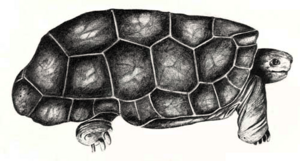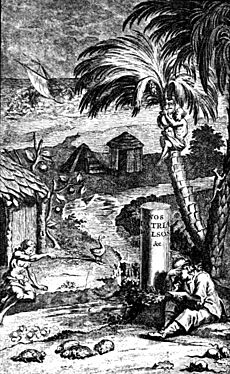Domed Rodrigues giant tortoise facts for kids
Quick facts for kids Domed Rodrigues giant tortoise |
|
|---|---|
 |
|
| Illustration from circa 1770 by Jossigny | |
| Conservation status | |
| Scientific classification | |
| Genus: |
Cylindraspis
|
| Species: |
peltastes
|
| Synonyms | |
|
|
The domed Rodrigues giant tortoise (Cylindraspis peltastes) was a type of giant tortoise. It is now extinct, meaning it no longer exists. This tortoise lived only on Rodrigues island. Scientists believe it died out around the year 1800. This happened mostly because of human activities.
What Did the Domed Rodrigues Tortoise Look Like?

The domed Rodrigues giant tortoise was one of the smaller giant tortoises from the Indian Ocean. It grew to be just over 40 cm (16 in) long. Its weight was around 12 kg (26 lb).
This tortoise ate mostly grasses. It lived on Rodrigues Island alongside a much larger relative. That relative was the saddle-backed Rodrigues giant tortoise. The saddle-backed tortoise ate taller plants. Both types of tortoises came from an older species on Mauritius. Their ancestors traveled to Rodrigues by sea millions of years ago. Over time, they changed into the two different Rodrigues species.
Why Did They Disappear?
When the first human settlers arrived, Rodrigues Island had many thousands of giant tortoises. They lived in large groups. Like many animals on islands, these tortoises were not afraid of humans. They were even curious and friendly.
However, people began to collect and export huge numbers of them for food. Also, new animals brought by humans, called invasive species, harmed the tortoises. These things quickly led to the tortoises dying out. Hundreds of thousands of tortoises were put onto ships. They were used for food or taken to Mauritius. There, they were burned to get fat and oil.
A few tortoises were reported to be alive in 1795. They were found at the bottom of a deep valley. Even in 1802, there were stories of surviving tortoises. They were said to have been killed in big fires. These fires were set to clear land for farming.
Scientists later learned that these giant tortoises were very important for the island's environment. They helped the forests grow back by eating plants. Because of this, people have started to bring in other tortoise species. These new tortoises are similar to the extinct ones. They help rebuild Rodrigues' damaged environment. For the domed Rodrigues tortoise, the radiated tortoise (Astrochelys radiata) from Madagascar was chosen. It is similar in size and habits.


